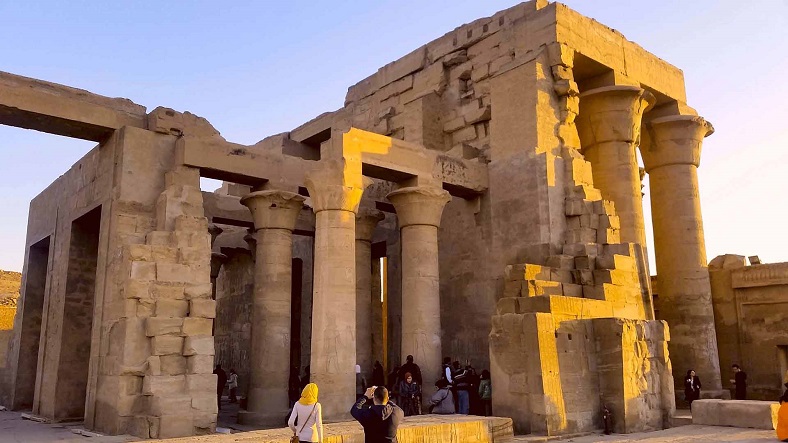The uniqueness of this temple is what makes it worth every visit? But wait! What is so unique about Temple of Kom Ombo?
Don’t worry! I am here to tell you every inch and detail about this temple.
-its location,
-who built it,
-what is so unique about it,
-threats to this temple,
-things to do and see at the temple
Keep reading to know more…
Where Is the Temple of Kom Ombo Located?
Kom Ombo is an Egyptian temple which is dedicated to two gods of ancient Egypt.
It is located along the Nile River in Kom Ombo, a town in Upper Egypt’s Aswan Governorate.
Who Built the Temple of Kom Ombo?
Ptolemy VI Philometor, the Egyptian king who reigned during the Ptolemaic period from 186 BC to 145 BC started its construction near the beginning of his rule. The future pharaohs of the dynasty enlarged the temple and added new features.
On the other hand, Ptolemy XIII, who ruled between 51 BC and 47 BC, made significant contributions to the temple. Also, he is credited with the completion of the hypostyle (a roof supported by columns) halls. Later, during the Roman period, a few additional features were added to the temple.
Religious Significance of the Temple of Kom Ombo
The temple is dedicated to two principal deities who were worshipped in two halves of the temple building.
Horus is the main deity of the northern half of the temple who is an ancient Egyptian god of the sky, hunting, and war. Horus is depicted in many forms but usually as a man with a falcon head. He was worshipped along with Hathor, the goddess of motherhood and joy, and Khonsu, the god of the moon.
Secondly, the southern part of the Temple of Kom Ombo is dedicated to Sobek, the ancient Egyptian god of fertility. Often represented as a man with a crocodile head, Sobek is also considered as the creator of the world. Here, Sobek was worshipped with Panebtawy, who is referred to as the Lord of the Two Lands, and goddess Tasenetnofret.
Know other places to visit in Egypt:
Unique Architecture attracts tourists!
It has a unique design that divides the temple of Kom Ombo into two perfectly symmetrical halves. Each part is dedicated to a set of gods. In each of these halves, the interior structures, such as halls and sanctuaries, are also duplicated. Moreover, its twin entrances lead to two connected hypostyle halls, which further lead to antechambers ending in the two sanctuaries.
It is believed that the current temple is in replacement of an older temple in the site.
How do people know that? Several reused blocks have been discovered in the structure of the temple.
Reliefs decorate the front facade of the temple and walls in the interior, which represent royal, mythological, and religious events, and aspects of the life of the ancient Egyptians.
Things to See and Do at the Temple of Kom Ombo
This temple will only interest people/ tourists who are really into ancient history, architecture or just want to know Egypt’s past. Apart from that, the Temple of Kom Ombo is an aesthetically beautiful structure.
Tourists are allowed to take photographs during their tour while exploring the entire temple. You can also hire a tour guide who will explain you the meaning of the gorgeous reliefs on the walls. These represent scenarios like the coronation of the Egyptian King, legends and mythological stories etc.
The most interesting relief represents a set of surgical instruments used in ancient times. It will give you a deeper understanding of Egyptian past. It is quite possible that these instruments were used by physicians for treating patients in the past. However, on the contrary, the scene must also represent instruments that might have been used in the daily rituals of the temple.
Some more Fun!
I suggest you to look at a non-operational “nilometer”. Basically, it is a structure that was used by the ancient Egyptians to measure the level of water in river to predict floods. Isn’t it astonishing?
Moreover, the nilometer at the Temple of Kom Ombo features a channel leading from the riverbank to a well. However, water now no longer reaches the well, which exists as a deep, cylindrical structure near the entrance to the temple area.
Outside of the temple is a Crocodile Museum that houses mummified crocodiles from previous times and other historical artifacts of ancient Egypt.
Is Kom Ombo Temple in Danger??
Since the temple is situated on the banks of the Nile, water erosion has destroyed several parts of the outer sections of the temple complex. However, it is currently well-preserved due to its high archeological value and you can enjoy exploring this Egyptian beauty!
What are you waiting for? Grab your tickets today and explore the mysterious temples of Egypt!











Leave a Reply
You must be logged in to post a comment.